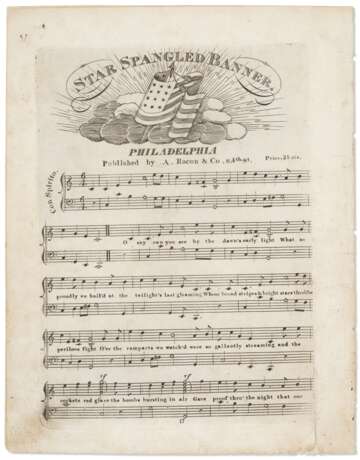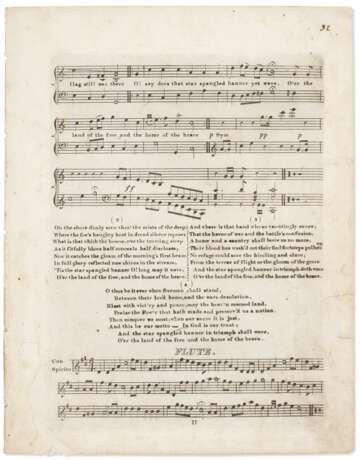ID 517686
Lot 40 | The first sheet music of the "Star Spangled Banner" to feature an American flag
Estimate value
$ 8 000 – 12 000
An early published edition of Francis Scott Key's "Star Spangled Banner" and the first to feature an American Flag. A rare example, bearing second edition points ("25¢") together with the publisher's plate number ("2"). Bacon's Philadelphia printing is closely copied from the Baltimore second edition. The engraving of the American flag below the title reveals twelve stars in three vertical rows, with two additional stars appearing behind the flag's fold which suggests the presence of two more rows to make the 18 stars necessary for the period (Indiana was admitted to the Union on 11 December 1816, making it the 19th state).
The chronology of the U.S. national anthem’s composition and earliest printings is well documented. It was written at a low point in the War of 1812, weeks after the British had captured Washington and burned the U.S. Capitol, turning next to attack Baltimore, a hotbed of American pro-war sentiment. Key, who had been a captive of the British fleet near the entrance to Baltimore Harbor since September 7th, spent the night of 13th-14th observing the battle together with two other American detainees, including a government agent for prisoner exchange named John Stuart Skinner. In the immediate aftermath, exultant at the British failure to subdue Fort McHenry and capture the city, Key began his rough draft of what would become “The Star Spangled Banner.” Over the next several days, the invaders abandoned their unsuccessful assault, withdrew their troops from the outskirts of the city, and prepared to set sail. Key and the other prisoners were released from captivity and returned to shore on the evening of the 16 September, and he finished composing the song in his room at a Baltimore inn the same night. Though a wildly popular tune at the time, the song did not become the nation's official national anthem until 1932.
Although the song was widely published and distributed at the time, few copies of any early editions published have survived. Of the earliest known edition, published in Baltimore in 1814, only eleven copies are known extant, the most recent sale of that edition was for $506,000 at Christie's, New York, 3 December 2010, lot 85. Filby & Howard recorded eight copies of this edition, not including the present one. Filby & Howard (S12); Muller 2a.
Two pages, bifolium, 320 x 251 mm (light soiling, a few tears neatly repaired). Penciled ownership inscription on verso: “Oliver Shaw Providence.”
| Address of auction |
CHRISTIE'S 20 Rockefeller Plaza 10020 New York USA | ||||||||||||||
|---|---|---|---|---|---|---|---|---|---|---|---|---|---|---|---|
| Preview |
| ||||||||||||||
| Phone | +1 212 636 2000 | ||||||||||||||
| Fax | +1 212 636 4930 | ||||||||||||||
| Conditions of purchase | Conditions of purchase | ||||||||||||||
| Shipping |
Postal service Courier service pickup by yourself | ||||||||||||||
| Payment methods |
Wire Transfer | ||||||||||||||
| Business hours | Business hours
|




